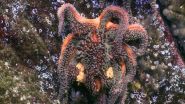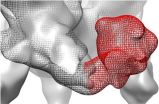(Press-News.org) November 17, 2014--Museum biological collections are the records of life on Earth and as such, they are frequently used to investigate serious environmental issues. When public health officials were concerned about the levels of mercury in fish and birds, for example, scientists studied museum specimens to assess historical changes in mercury contamination. Eggs in museum collections were analyzed to establish the connection between DDT, thinning eggshells, and the decline in bird populations. And now, specimens from the Natural History Museum of Los Angeles County (NHM) have helped explain the mysteriously sudden appearance of a disease that has decimated sea stars on the North American Pacific Coast.
In a paper published Monday, November 17, 2014 in the journal Proceedings of the National Academy of Sciences, Cornell University microbiologist Ian Hewson and colleagues identify the Sea Star Associated Densovirus (SSaDV) virus as the microbe responsible for Sea Star Wasting Disease (SSWD). NHM Curator of Echinoderms Gordon Hendler and Collections Manager Cathy Groves, along with scientists from universities and aquariums along the coast (including NHM neighbor, the California Science Center), collaborated in the study.
Since June 2013, the largest die-off of sea stars ever recorded has swept the Pacific Coast. At least 20 different species of sea stars have been affected -- including iconic species like the "ochre star" and the multi-armed "sunflower star" -- and many populations of sea stars from Southern Alaska to Baja California have already disappeared.
Their large-scale disappearance is anticipated to have a serious and long-lasting ecological impact on coastal habitats, because sea stars are voracious predators, with a key role in regulating the ecology of the ocean floor.
Museum samples prove that the virus has existed at a low level for at least the past 72 years -- it was detected in preserved sea stars collected in 1942, 1980, 1987, and 1991. The study suggests the disease may have recently risen to epidemic levels because of sea star overpopulation, environmental changes, or mutation of the virus.
The study detected the virus on particles suspended in seawater, as well as in sediment, and showed that it is harbored in animals related to sea stars, such as sea urchins and brittle stars. Likely it can be transported by ocean currents, accounting for its rapid, widespread dispersal in the wild. Since the die-off began, the disease has caused a mass mortality of captive sea stars in aquariums on the Pacific Coast, although it did not spread in aquariums that sterilize inflowing seawater with UV light.
"There are 10 million viruses in a drop of seawater, so discovering the virus associated with a marine disease can be like looking for a needle in a haystack," Hewson said. In fact, the densovirus is the first and only virus identified in sea stars. However, its discovery will enable scientists to study how the virus infects sea stars and trace it in the ocean. Further research could reveal how the virus invades its host, why kills some sea stars, and why other species are unaffected.
Research might also identify factors that triggered the ongoing plague and help to predict or forestall similar events in the future.
"A recent publication highlighted examples of innovative studies for which museum time-series were integral in identifying responses to environmental change and bemoaned general decline in the growth of museum collections," said NHM's Hendler. "Fortunately, we bucked the trend and intentionally collected common, local species of sea stars, which made it possible to detect SSaDV in specimens from NHM!"
INFORMATION:
About the Natural History Museum:
The Natural History Museum of Los Angeles County is a national leader in research, exhibitions and education. The Museum was the first dedicated museum building in Los Angeles, opening its doors in 1913. It has amassed one of the world's most extensive and valuable collections of natural and cultural history -- with more than 35 million objects, some as old as 4.5 billion years. For more information, visit the Museum's website at http://www.nhm.org or call (213) 763-DINO.
CHICAGO - Black patients who have been diagnosed with heart failure are no less likely than white patients to get atrial fibrillation (an irregular heartbeat, or arrhythmia), according to a new study led by researchers in the Perelman School of Medicine at the University of Pennsylvania, which was presented today at the 2014 Scientific Sessions of the American Heart Association. These findings run counter to previous studies, which have found that black patients with heart failure tend to have less atrial fibrillation problems than white patients.
"Even though ...
ROCHESTER, Minn. -- The investigational drug ixazomib taken orally in combination with lenalidomide and dexamethasone shows promise in patients with newly diagnosed multiple myeloma, according to the results of a phase 1/2 study published in the journal Lancet Oncology.
"Ixazomib is an investigational, oral proteasome inhibitor with promising anti-myeloma effects and low rates of peripheral neuropathy," says Shaji Kumar, M.D., a hematologist at Mayo Clinic and lead author of the study. "While it is well known that a combination of bortezomib, lenalidomide and dexamethasone ...
iRhythm Technologies, Inc. announced today that study results presented during the American Heart Association (AHA) Scientific Sessions showed an association between a high burden of atrial fibrillation (AFib) and lower cognitive function, specifically executive and verbal function. Previous studies have shown a relationship between AFib, cognitive decline and increased risk of dementia. However, this study, which was led by researchers at the University of Minnesota, demonstrates for the first time a correlation between high AFib burden - the percent of time a person has ...
Amsterdam, NL, 17 November 2014 - Two simple tests conducted during the neurological exam can help clinicians differentiate between early-stage Parkinson's disease (PD) and atypical parkinsonism. By asking patients to perform a tandem gait test and inquiring whether they are still able to ride a bicycle, clinicians can ascertain whether medio-lateral balance is impaired, a defining characteristic of atypical parkinsonism. These findings are published in the Journal of Parkinson's Disease.
This issue of the Journal of Parkinson's Disease also marks the inauguration of ...
Why is Jamaica, with a population smaller than that of Los Angeles, home to so many of the world's elite sprinters - runners who compete in the 100, 200, 400 and 800-meter races?
Robert Trivers, an evolutionary biologist and professor of anthropology and biology in the School of Arts and Sciences, set out with his colleagues to find out if there was something about the symmetry of their knees that might partly explain this phenomenon. They already knew from their earlier research that the symmetry of children's knees at age 8 predicts how fast a person runs 14 years later ...
The sun emitted a mid-level solar flare, peaking at 12:48 p.m. EST on Nov. 16, 2014. NASA's Solar Dynamics Observatory, which watches the sun constantly, captured an image of the event. Solar flares are powerful bursts of radiation. Harmful radiation from a flare cannot pass through Earth's atmosphere to physically affect humans on the ground, however -- when intense enough -- they can disturb the atmosphere in the layer where GPS and communications signals travel.
To see how this event may affect Earth, please visit NOAA's Space Weather Prediction Center at http://spaceweather.gov, ...
Here's another reason to pay close attention to microbes: Current climate models probably overestimate the amount of carbon that will be released from soil into the atmosphere as global temperatures rise, according to research from the US Department of Energy's Lawrence Berkeley National Laboratory (Berkeley Lab).
The findings are from a new computer model that explores the feedbacks between soil carbon and climate change. It's the first such model to include several physiologically realistic representations of how soil microbes break down organic matter, a process that ...
Fruit flies do not always conform to the norm. When female fruit flies have to decide where to lay their eggs, they take their lead from what they see most others in their group do. However, some do take their personal preferences into account. So says Marine Battesti of the Université Paris-Sud in France, lead author of a study in Springer's journal Behavioral Ecology and Sociobiology.
The site on which an insect chooses to lay her eggs is very important for the development and survival of future generations. Such choices are not fixed, but are influenced by the ...
UC Davis researchers are getting a new look at the workings of HIV and other viruses thanks to new techniques in electron microscopy developed on campus.
The envelope (or Env) protein of HIV is a key target for vaccine makers: it is a key component in RV144, an experimental vaccine that is so far the only candidate to show promise in clinical trials. Also called gp120, the Env protein associates with another protein called gp41 and three gp120/gp41 units associate to form the final trimeric structure. The gp120 trimer is the machine that allows HIV to enter and attack ...
WASHINGTON, Nov. 17, 2014 -- They are seemingly the most popular thing on the Internet, the subject of millions of videos and hundreds of memes: cats. This week Reactions answers some of the biggest kitty questions out there: Why does catnip make most cats go crazy? What does it mean when your cat rubs against your leg? How does kitty litter clump? Check out the nearly purr-fect video here: http://youtu.be/6_C9i-2QGeU.
Subscribe to the series at Reactions YouTube, and follow us on Twitter @ACSreactions to be the first to see our latest videos.
INFORMATION:
The American ...




